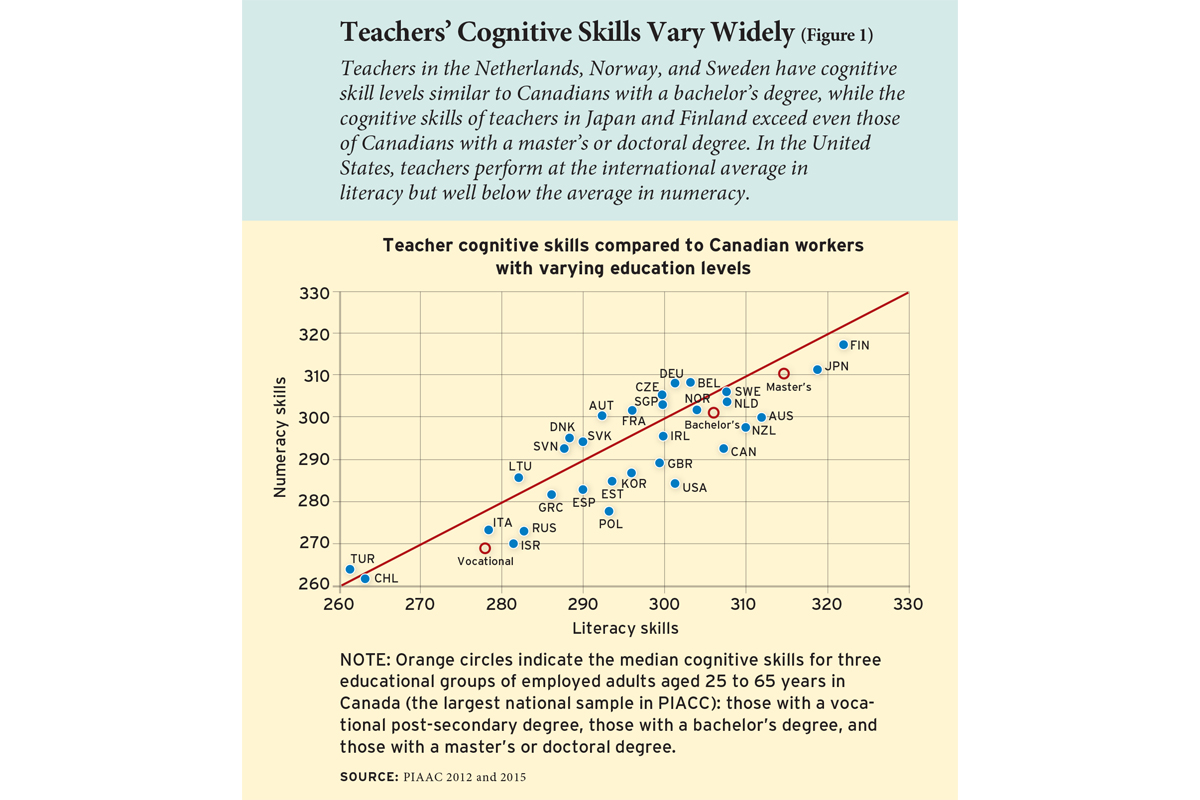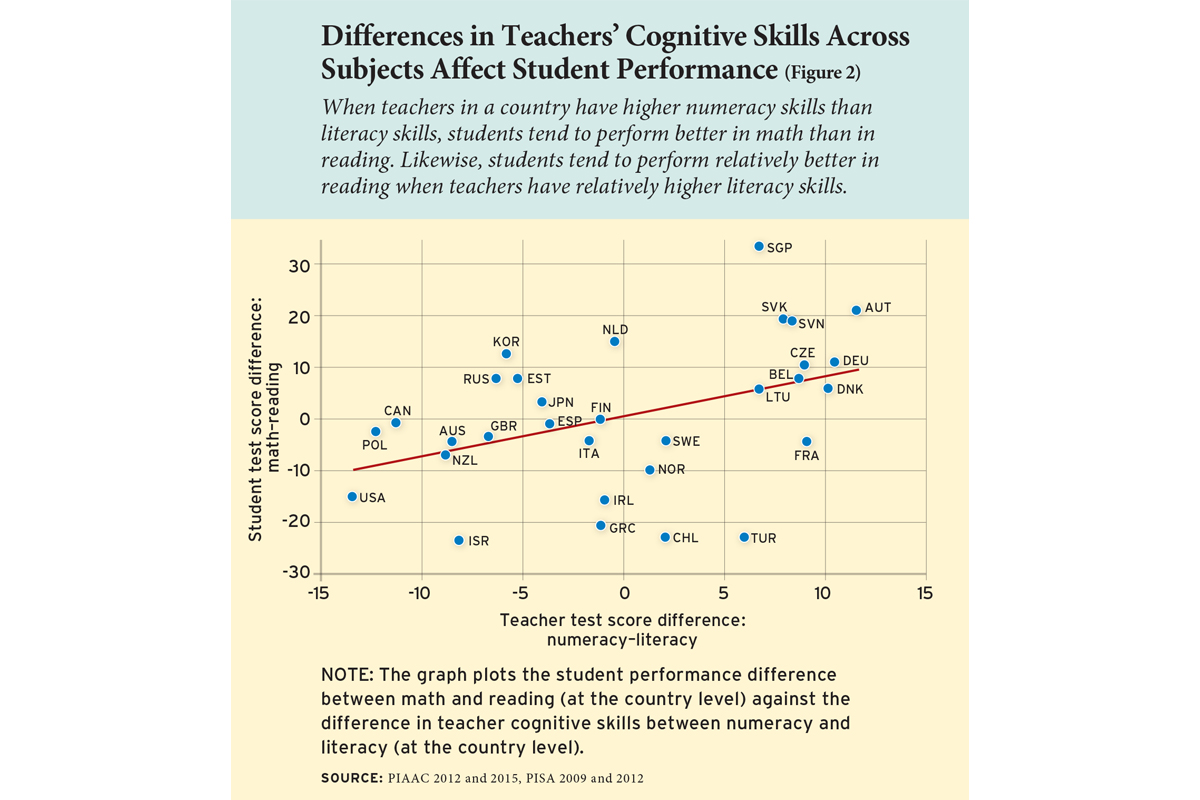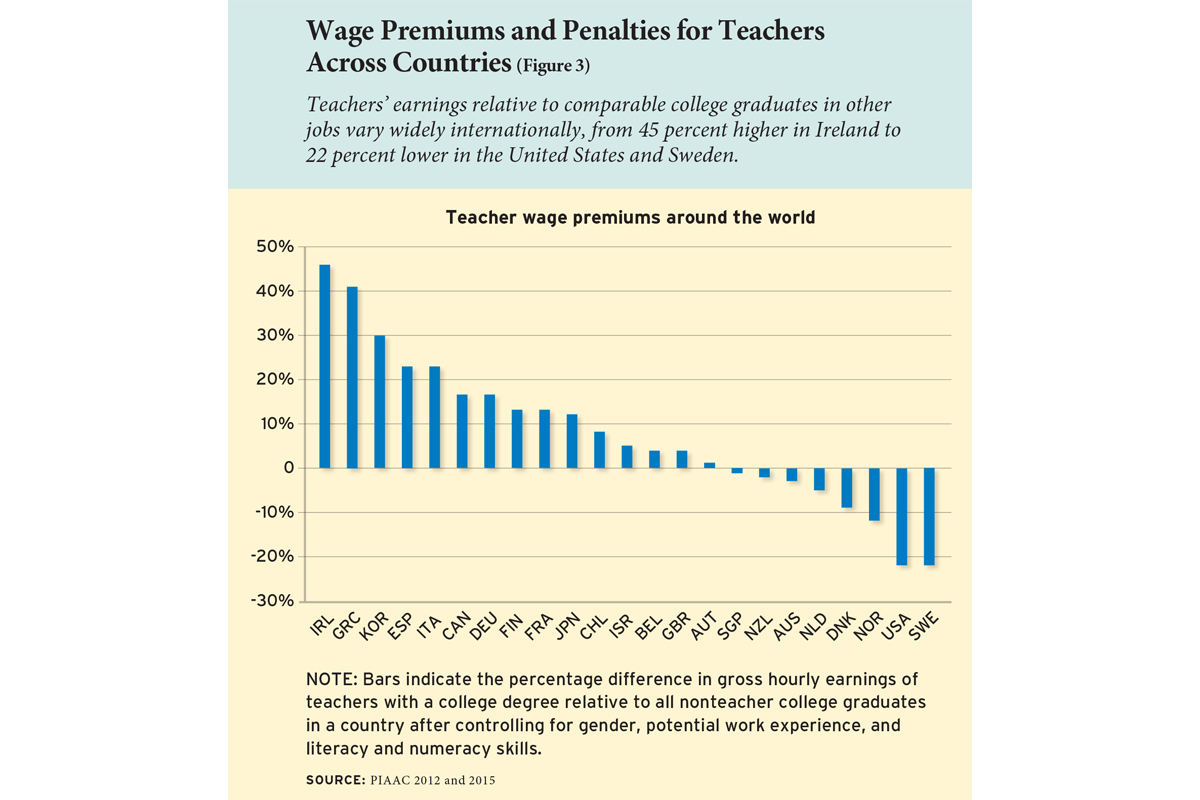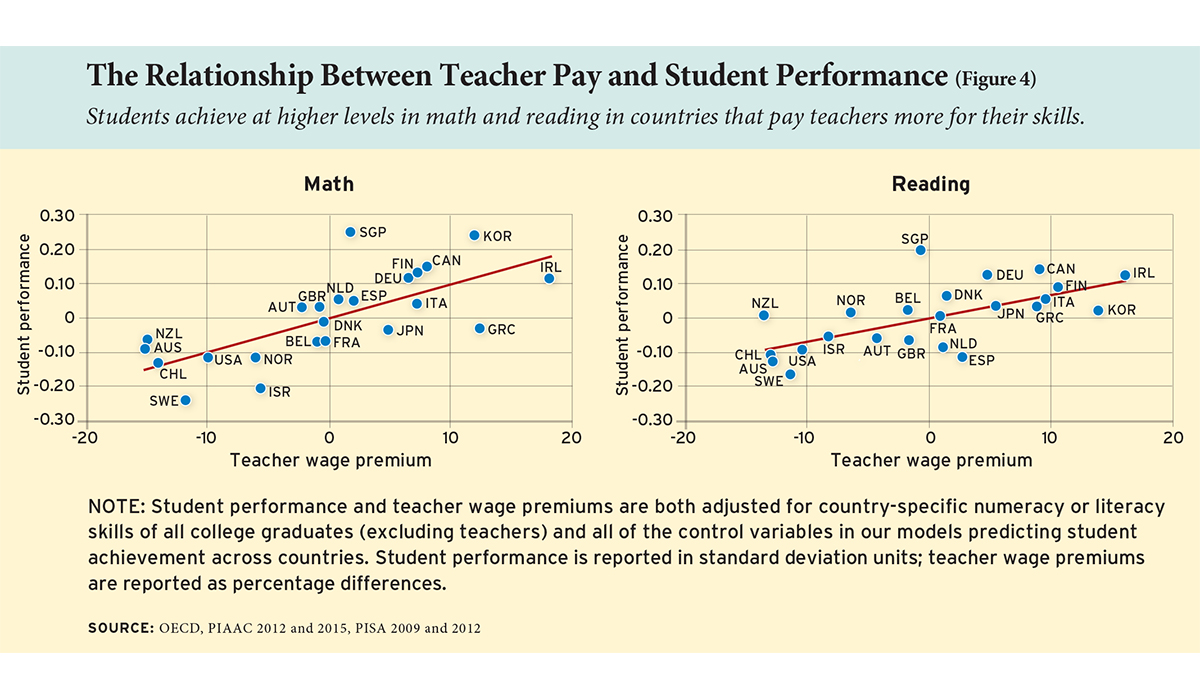 Student achievement varies widely across developed countries, but the source of these differences is not well understood. One obvious candidate, and a major focus of research and policy discussions both in the United States and abroad, is teacher quality.
Student achievement varies widely across developed countries, but the source of these differences is not well understood. One obvious candidate, and a major focus of research and policy discussions both in the United States and abroad, is teacher quality.
Research and common sense tell us good teachers can have a tremendous impact on their students’ learning. But what, exactly, makes some teachers more effective than others? Some analysts have pointed to teachers’ own scholastic performance as a key predictor, citing as examples teacher-recruitment practices in countries where students do unusually well on international tests. One oft-cited statistic notes that high-scoring Singapore, Finland, and Korea recruit their teacher corps exclusively from the top third of their academic cohorts in college; by contrast, in the U.S., just 23 percent of new teachers come from the top third of their graduating class.
Can we provide systematic evidence that teachers’ cognitive skills matter for student achievement? Do smarter teachers make for smarter students? And if so, how might we recruit teachers with stronger cognitive skills in the U.S.?
To investigate these questions, we look at whether differences in the cognitive skills of teachers can help explain differences in student performance across developed countries. We consider data from the Organization for Economic Cooperation and Development (OECD), an association of 36 largely developed countries that has assessed nationally representative samples of both adults and students in reading and math. We use these data to estimate the effects of teacher cognitive skills on student achievement across 31 OECD countries.
We find that teachers’ cognitive skills differ widely among nations—and that these differences matter greatly for students’ success in school. An increase of one standard deviation in teacher cognitive skills is associated with an increase of 10 to 15 percent of a standard deviation in student performance. This implies that as much as one quarter of the gaps in average student performance across the countries in our study would be closed if each of them were to raise their teachers’ cognitive skills to the level of those in the highest-ranked country, Finland.
We also investigate two explanations for why teachers in some countries are smarter than in others: differences in job opportunities for women and in teachers’ salaries compared to those of other professions. We find that teachers have lower cognitive skills, on average, in countries with greater non-teaching job opportunities for women in high-skill occupations and where teaching pays relatively less than other professions. These findings have clear implications for policy debates here in the U.S., where teachers earn some 20 percent less than comparable college graduates.
The importance of teacher quality
While many factors influence student success, the most convincing research has focused on differences in learning gains made by students assigned to different teachers. Studies of teachers’ contributions to student reading and math achievement consistently find variations in “value-added” that far exceed the impact of any other school-based factor.
These studies are unhelpful in explaining international differences in student achievement, however: they focus primarily on the U.S. and have not identified correlates of teacher value-added that can be measured consistently across countries. Such differences are a major concern for the United States, where policymakers are searching for strategies to shore up the country’s economic competitiveness. American students score rather unimpressively on the OECD’s Program for International Student Assessment (PISA), which measures high-school students’ skills in math, reading, and science every three years. On the most recent PISA math assessment in 2015, for example, American teenagers ranked 40th, well below most major Asian and European countries.
Importantly, research conducted within the U.S. and in other settings has shown that common measures of teacher qualifications such as advanced degrees, experience levels, and professional preparation are not consistently related to classroom effectiveness. The story differs for research on teacher cognitive skills and salaries, however, in ways that motivate our analysis in this article.
Prior studies of teacher cognitive skills, largely from within the U.S., provide some evidence of positive impacts on student achievement. These studies have relied on small and idiosyncratic data sets, and their results are not entirely uniform. Nonetheless, compared to alternative measures of teacher quality, test scores are most consistently related to student outcomes.
The relevant evidence on teacher salaries is different. While studies conducted within specific countries tend to find that salaries are unrelated to effectiveness, the limited available cross-country evidence suggests that students perform better where teachers are better paid. These divergent results suggest that salary levels may have important ramifications for the quality of the overall pool of potential teachers—even if the distribution of salaries within a country is not a good index of effectiveness.

Measuring teacher cognitive skills
To measure teacher cognitive skills, we use data from the OECD’s Program for the International Assessment of Adult Competencies (PIAAC) survey in 2012 and 2015, which tested the literacy and numeracy skills of more than 215,000 randomly selected adults age 16–65 in 33 countries. We focus on the 6,402 test-takers in 31 countries (those where we also have information on student achievement) who reported their occupation as “primary school teacher,” “secondary school teacher,” or “other teacher.” The number of teachers tested ranges from 106 in Chile to 834 in Canada, with 207 per country on average. We use the median literacy and numeracy scores of the teachers tested in each country as our measures of teachers’ cognitive skills.
These data reveal vast differences in teacher cognitive skills across countries. Figure 1 compares median teacher numeracy and literacy skills in each country to the skills of all employed adults in different educational groups within Canada, the country with the largest PIAAC sample. Teachers in Turkey and Chile score well below Canadian adults with only a vocational post-secondary degree, while teachers in Italy, Russia, and Israel perform at the level of vocationally educated Canadians. At the other end of the spectrum, the skills of teachers in Japan and Finland are higher than those of Canadians with a master’s or doctoral degree. Teachers in the Netherlands, Norway, and Sweden have skill levels similar to Canadians with a bachelor’s degree.
Teachers in the United States perform worse than the average teacher sample-wide in numeracy, with a median score of 284 points out of a possible 500, compared to the sample-wide average of 292 points. In literacy, they perform slightly better than average, with a median score of 301 points compared to the sample-wide average of 295 points. While teacher literacy skills are higher than numeracy skills in some countries (including the U.S.), the reverse is true in others—a pattern we will return to below when examining the consequences of differences in teacher skills across subjects.
These differences in teacher cognitive skills reflect both where teachers are drawn from within each country’s skill distribution and where a country’s overall cognitive-skill level falls in the world distribution. While median teacher cognitive skills are close to the median skills of college graduates in most countries, teachers perform better than the median college graduate in countries like Finland, Singapore, Ireland, and Chile, and perform worse than the median college graduate in others, such as Austria, Denmark, the Slovak Republic, and Poland.
However, teachers from relatively lower parts of the distribution may have greater cognitive skills than their peers abroad if their home country’s skill level is higher overall. For example, math teachers in Chile and Finland are drawn from similarly high levels of their overall distributions of college graduates, yet Chilean teachers score at the bottom of all 31countries while Finnish teachers score at the top. Teachers from the Slovak Republic are drawn from the lowest point in the country skill distribution of the 31 countries, yet have teachers in the middle of the international skill distribution of teachers.
Measuring student achievement
Our data on student achievement come from PISA in 2009 and 2012, which tested the math and reading skills of more than a half million 15-year-old students in nationally representative samples in more than 60 countries, including 31 of the countries participating in PIACC. We use those two PISA cycles because participating students would have been taught by the teacher cohorts tested in 2012 and 2015 in PIAAC.
Student performance in math and reading also varies widely across the countries in our sample, with especially pronounced differences in math. Students in top-performing Singapore scored 70 points above the sample-wide average of 498—the equivalent of nearly two school years. U.S. students scored well below that average at 484. In reading, Singapore students again earned the highest score of 534 compared to 445 for Chile, the lowest-scoring country in our sample. The U.S. score of 498 was not statistically different from the average of 497—leaving American students roughly one school year behind students in Singapore.
Linking teacher and student skills
How do these differences in student achievement relate to international differences in teachers’ cognitive skills? We use two different approaches to address this question. In both, we measure teacher cognitive skills only at the country level, in part because our data do not let us link students to their actual teachers but also to avoid bias due to factors such as parents choosing better schools and teachers for their children.
We first examine the association between median teacher cognitive skills and individual students’ performance across the 31 countries in our sample. That is, we ask whether students perform better on the PISA math and reading tests when their country’s teachers have stronger numeracy and literacy skills, respectively. In making these comparisons, we control for a wide range of other factors that could influence students’ performance. These factors include the skill levels of all adults age 25–65 as measured by PIACC; student characteristics such as age, gender, and migrant status; family background characteristics such as parents’ education levels and the number of books in the home; school characteristics such as enrollment size and instructional time in math and reading; and the average per-pupil spending and school starting age in each country. Importantly, we also control for a measure of the cognitive skills of the parents of PISA test-takers, as estimated based on the relationship between demographic characteristics and cognitive skills among parents tested in PIACC.
Despite these adjustments, however, the relationship between teacher skills and student achievement we estimate in our first approach could still reflect differences between countries that are more difficult to measure. Countries that emphasize the importance of a good education, for example, may have both teachers with high cognitive skills and parents who do more to support their children’s education in the home.
To address this concern, our second approach exploits the fact that both students and teachers were tested in two subjects and asks whether differences in teacher cognitive skills between numeracy and literacy are systematically related to differences in student performance between math and reading. In other words, do students perform relatively better in math (compared to reading) in countries where teachers have relatively higher numeracy skills? By focusing on comparisons within the same country, this approach eliminates the influence of any differences across countries that affect student achievement similarly in both subjects.
The only lingering concern is the possibility of unmeasured differences between countries that are subject-specific. For example, the results of our second approach would be biased if parents in societies where teachers have strong numeracy skills place more value on supporting their children in math than in reading. We provide evidence that such factors are unlikely to be important below.
Cross-country comparisons
Our first approach reveals a strong relationship between teacher cognitive skills and student achievement across countries. We estimate that increasing teacher numeracy skills by one standard deviation increases student performance by nearly 15 percent of a standard deviation on the PISA math test. Our estimate of the effect of increasing teacher literacy skills on students’ reading performance is slightly smaller, at 10 percent of a standard deviation, but the difference in magnitude across the two subjects is not statistically significant. Further analysis shows that the impact of teacher skills is somewhat larger for girls than for boys and for low-income students compared to wealthier students, particularly in reading.
As expected, a country’s cognitive skill level of all adults (age 25–65) is also strongly correlated with student performance. However, when controlling for teacher cognitive skills, the estimates for adult skills substantially decrease in size and lose statistical significance. In other words, the relationship between teacher cognitive skills and student performance is not driven by overall skill levels in the country; it is what teachers know that matters.
How much does it matter? To gauge the magnitude of our estimates, we simulate the improvements in student performance if each country brought its teachers up to the cognitive-skill level of Finnish teachers, the highest-skilled teachers in our sample. In math, U.S. students would improve by roughly one third of a standard deviation, and students in lowest-ranked Turkey and Chile would improve by more than half of a standard deviation. Overall, we estimate that bringing teachers in each country to the Finnish level would reduce the dispersion of country-level PISA scores by about one quarter, reducing the standard deviation of scores from 29 to 22 points in math and from 22 to 16 points in reading.
Improvements of this size may not be realistic in the short run for many countries, however. To match the cognitive skills of Finnish teachers, Turkey would have to draw its median teacher from the 97th percentile of the college numeracy distribution instead of the 53rd percentile. The U.S. would need to recruit its median math teacher from the 74th percentile instead of the current 47th percentile, and its median reading teacher from the 71st percentile instead of the 51st.
It is also important to note that the teacher-skill estimates do not capture the effect of a single school year with a talented teacher but rather reflect the cumulative effect of teacher cognitive skills on student performance through age 15. Thus, these projections are long-run impacts that presume that the quality of students’ teachers across the first 10 grades would improve to the level of Finland.

Within-country comparisons
While teacher cognitive skills are significantly related to student performance in both math and reading, it remains possible that this association is driven by unobserved differences across countries. Therefore, we now exploit only within-country variation to provide even more rigorous evidence on the effect of teacher cognitive skills on student performance.
The overall story is easy to see in a simple graphic: differences in teacher cognitive skills between numeracy and literacy are systematically related to differences in student performance between the same two subjects (see Figure 2). Remarkably, the magnitude of the relationship is very similar to that observed in the cross-country analysis: an increase of teacher cognitive skills of one standard deviation is estimated to improve student achievement by 11 percent of a standard deviation.
Our confidence in this result is strengthened by various “placebo” tests, all of which indicate that our estimates reflect the impact of teacher cognitive skills and not just those of the broader society.
In the first placebo test, we replace teacher cognitive skills with the cognitive-skill level of workers in 14 other occupations, including managers, scientists and engineers, health professionals, business professionals, clerks, sales workers, and service workers. If our results for teachers were really just the result of countries differentially valuing numeracy or literacy, we would expect to find an “effect” of these other workers’ skills on student test scores as well. Instead, we find there is no occupation other than teaching whose skill level is systematically related to student performance.
In a second placebo test, we replace teacher skills by the skill level of a randomly chosen sample of adults matched by age, gender, and educational attainment to the teacher sample in each country. We then draw 100 samples of matched “teacher twins” and compare their estimated student impacts. None of the 100 samples of teacher twins produces larger impacts than teachers.
We also investigate cross-subject effects, that is, the effect of teachers’ numeracy skills on student reading performance and the effect of teacher literacy skills on student math performance. If it is subject-matter skills that are important, as we have assumed in our within-country analysis, then teacher skills in one subject should be only weakly related—if at all—to student performance in the other subject.
Consistent with this logic, we find that teacher numeracy skills have a substantially larger association with student math performance than with reading performance. Similarly, teacher literacy skills are more important for student reading performance than for math performance. The most convincing evidence comes from simultaneously including teacher numeracy and literacy skills. Here, teacher skills in either subject affect only student performance in the same subject.

Creating a smarter teacher workforce
International differences in teacher cognitive skills reflect both where teachers are drawn from in each country’s skill distribution as well as the overall skill level of each country’s population—and policies to improve teacher skills could in theory focus on either of these dimensions. While improving the cognitive skills of the entire population is a valuable goal, it has been widely discussed elsewhere. In contrast, the determinants of where teachers are drawn from the overall skill distribution of a country’s population has received little attention. Our international data enable us to investigate how external forces and policy choices affect the part of the overall skill distribution from which countries recruit their teachers.
We examine two major factors. First, how has teaching been affected by competition from other occupations that demand high skills? In most countries, women historically have been segregated into a constrained set of occupations, one of which is teaching, and teaching remains a female-dominated occupation worldwide. Across the 23 countries used in the analysis below (where we exclude Turkey and all post-Communist countries due to their distinctive labor-market histories), more than two thirds (69 percent) of teachers are female, ranging from 59 percent in Japan to 79 percent in Austria. At the same time, women previously were much more concentrated in teaching than they are today, and the extent of this change varies across countries.
To compare women’s access to high-skill occupations across countries and over time, we compute the proportion of female teachers relative to the number of females in all high-skill occupations in three cohorts of adults defined by their birth years. We define what counts as a high-skill occupation empirically for each country, based on the average years of schooling among males working in each job category.
For both numeracy and literacy, we find that teacher cognitive skills are higher in countries where more females work in teaching relative to other high-skill occupations. The size of these relationships is quite substantial. For example, across all 23 countries in the sample, the share of women in high-skill occupations who are teachers decreases from 29 percent in the oldest age cohort (born in years 1946–1960) to 22 percent in the youngest cohort (born 1976–1990), reflecting the increased availability of alternative job opportunities for women over time. Our results imply that this change is associated with a decline in teacher numeracy skills of one quarter of a standard deviation. Another benchmark comes from comparing the share of women in high-skill occupations who are teachers across countries, which ranges from 18 percent in the U.S. to 38 percent in Singapore. Our estimates suggest that if the employment choices of U.S. women were as constrained as those in Singapore, the numeracy skills of U.S. teachers would be nearly three quarters of a standard deviation higher, lifting them to just above the international average.
While these results shed light on one important explanation for differences in teacher cognitive skills, restricting job opportunities for women is hardly an appealing strategy to improve teacher quality. Our second analysis, therefore, focuses on the impact of teacher pay on teachers’ cognitive skills.
To investigate the salary-skills relationship across countries, we first estimate whether teachers are paid a positive or negative wage premium compared to other college graduates with the same gender, work experience, and literacy and numeracy skills. We find a wide range of wage premiums, ranging from a positive 45 percent in Ireland to a negative 22 percent in the United States and Sweden (see Figure 3). This means that American teachers are paid 22 percent less than comparably experienced and skilled college graduates doing other jobs.
We then assess how these pay premiums relate to the position of teachers in a country’s skill distribution, and we find that countries that pay teachers more also tend to draw their teachers from higher parts of the college skill distribution. In terms of magnitude, a higher teacher wage premium of 10 percentage points is associated with an increase in teacher skills of about one tenth of a standard deviation for a given level of college graduates’ skills. Those pay choices appear to carry through to student performance in the classroom (see Figure 4). In countries where teachers are better paid, students achieve higher levels.

Implications
Our findings have broad application for American policymakers aiming to build a better teaching workforce. Prior research conducted within the U.S. has highlighted the importance of teacher quality for student achievement. But while such work provides useful information about relative learning gains among current teachers, it does not indicate what would be possible if the teacher corps were drawn from a different pool of candidates. Rather than assessing the relative talent of our current workforce, our study of teachers in 31 countries suggests what might be possible if the pool of potential teachers in the U.S. resembled those in the most successful education systems in the world.
To be sure, our work does not speak definitively to the sources of individual teacher talent. But we find that differences in teacher cognitive skills across countries are strongly associated with international differences in student performance. An increase in teacher cognitive skills of one standard deviation is associated with an increase in student performance of as much as 15 percent of a standard deviation in the PISA test.
Our international data also allow us to investigate how external forces and policy choices affect the skills of the teaching force and ultimately, student outcomes. We find that cross-country differences in women’s access to high-skill occupations and in wage premiums paid to teachers (given their gender, work experience, and cognitive skills) are directly related to teacher cognitive skills in a country. Teachers’ wage premiums are also highly correlated with student achievement across countries.
These results speak to the potential value of increasing teacher pay but must be interpreted with care. In particular, we have not provided causal estimates of how the quality of teachers would change if teacher salaries in the U.S. were raised. Increasing teacher salaries would undoubtedly expand the pool of potential teachers and help to reduce teacher turnover. Our evidence does not, however, indicate that more talented teachers would be hired out of the enlarged pool, nor does it indicate that the teachers induced to stay in the profession would be the most effective. Thus, while making it clear that a more skilled teaching force is generally found in countries with higher relative salaries, policymakers will need to do more than raise teacher pay across the board to ensure positive results. They must ensure that higher salaries go to more effective teachers.
Eric A. Hanushek is the Paul and Jean Hanna Senior Fellow at the Hoover Institution of Stanford University. Marc Piopiunik is an economist at the ifo Center for the Economics of Education at the CESifo Group. Simon Wiederhold is professor at the Catholic University, Eichstätt-Ingolstadt. This article is based on “The Value of Smarter Teachers: International Evidence on Teacher Cognitive Skills and Student Performance,” which is forthcoming in the Journal of Human Resources.
This article appeared in the Spring 2019 issue of Education Next. Suggested citation format:
Hanushek, E.A., Piopiunik, M., and Wiederhold, S. (2019). Do Smarter Teachers Make Smarter Students? International Evidence on Teacher Cognitive Skills and Student Performance. Education Next, 19(2), 56-64.


